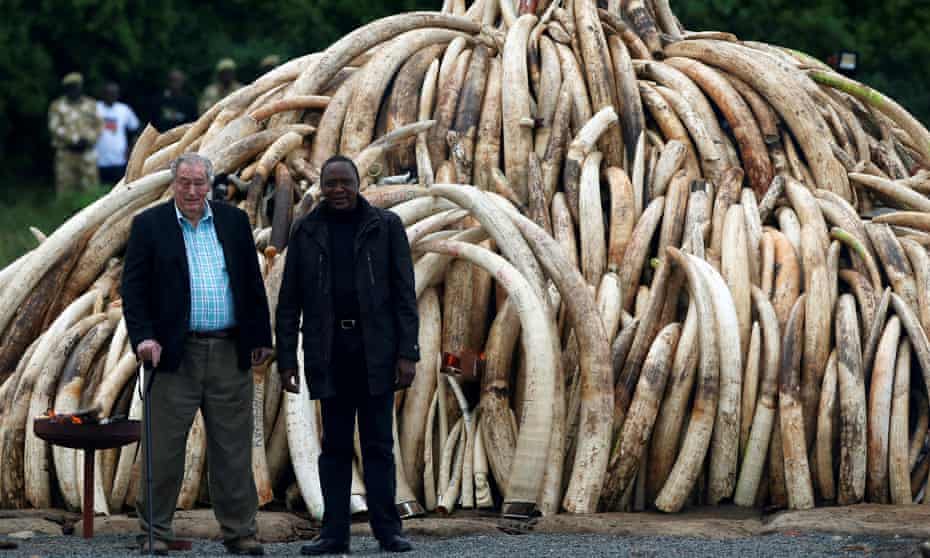Extract from The Guardian
Kenyan conservationist found oldest near-complete human skeleton in 1984, dating from 1.5m years ago.

The chair of the Kenyan Wildlife Service, Richard Leakey, alongside the Kenyan president, Uhuru Kenyatta, with confiscated ivory and rhino horn in 2016.
The president of Kenya, Uhuru Kenyatta, announced Leakey’s death with “deep sorrow”.
The famed palaeoanthropologist had remained energetic into his 70s, despite bouts of skin cancer and kidney and liver disease.
Posting on Twitter, the Leakey Foundation wrote of its “deep sadness” at his death, adding: “He was a visionary whose great contributions to human origins and wildlife conservation will never be forgotten.”
Leakey was born in Nairobi on 19 December 1944 – and it was perhaps inevitable that he would become a fossil hunter given his parents were Louis and Mary Leakey, perhaps the world’s most famous discoverers of ancestral hominids.

Dr Richard Leakey in 2016. Photograph: Brad Barket/Getty Images
Although Leakey initially tried his hand at safari guiding, aged 23 – and with having no formal archaeological training – he won a research grant to dig on the shores of northern Kenya’s Lake Turkana.
During the 1970s he led expeditions that shed new light on the scientific understanding of human evolution, with the discovery of the skulls of Homo habilis (1.9m years old) in 1972 and Homo erectus (1.6m years old) in 1975.
He made the cover of Time magazine posing with a Homo habilis mock-up, under the headline How Man Became Man.
Just a few years later, in 1984, he would enjoy his most famous fossil find: the uncovering of a near-complete Homo erectus skeleton during one of his digs. Nicknamed Turkana Boy, it dated from approximately 1.5m years ago and is the most complete fossil skeleton of a human ancestor ever found.
During this decade Leakey became one of the world’s leading voices against the then legal global ivory trade. In 1989 the Kenyan president Daniel arap Moi appointed him to lead the national wildlife agency, which became the Kenya Wildlife Service (KWS).
Softly spoken and seemingly devoid of personal vanity, Leakey’s campaigning methods could nevertheless be eye-catching.
He masterminded a spectacular publicity stunt of burning a pyre of ivory by setting fire to 12 tonnes of tusks – making the point that once removed from elephants they had no value.
He also held his nerve when implementing a shoot-to-kill order against armed poachers.
Leakey’s illustrious career, however, was beset with health challenges. In 1969 he was diagnosed with terminal kidney disease.
Ten years later and seriously ill he received a kidney transplant from his brother, Philip, and recovered to full health.
Then in 1993 his small Cessna plane crashed in the Rift Valley. He survived but lost both legs. Sabotage was suspected but never proved.
He told the Financial Times that he endured “regular threats” and lived with armed guards, adding: “But I made the decision not to be a dramatist and say: ‘They tried to kill me.’ I chose to get on with life.”
Leakey was eventually forced out of KWS and began a career as a prominent opposition politician, joining the voices against Moi’s corrupt regime.
His political career met with less success, and in 1998 he was appointed by Moi to head Kenya’s civil service in charge of fighting official corruption. The task proved impossible, however, and he resigned after just two years.
In 2015, as another elephant-poaching crisis gripped Africa, Kenyatta invited Leakey back to KWS, this time as chairman of the board, a position he would hold for three years.
Dr Paula Kahumbu, the head of Wildlife Direct, a conservation group founded by Leakey, paid tribute on Twitter, saying: “Richard was a very good friend and a true loyal Kenyan. May he Rest In Peace.”
No comments:
Post a Comment